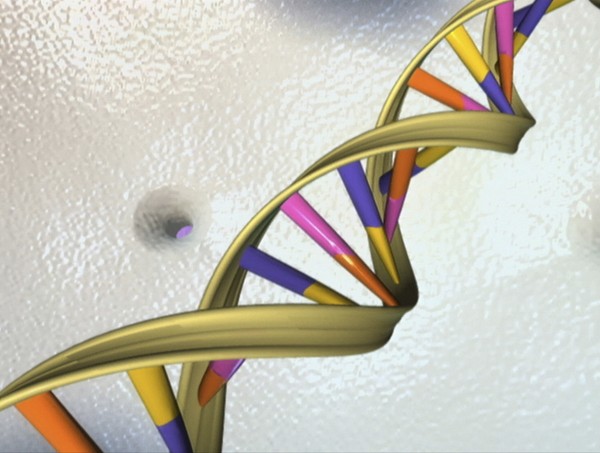An Evolutionary "Arms Race" Shaped the Human Genome
| Marc Maligalig | | Sep 29, 2014 02:29 AM EDT |
(Photo : REUTERS/National Human Genome Research Institute/Handout) A DNA double helix is seen in an undated artist's illustration released by the National Human Genome Research Institute.
An evolutionary arms race involving rival elements within the genomes of primates spurred the evolution of compound regulatory systems that manage what the genes do in every cell in the body, suggested researchers from the University of California, Santa Cruz.
The arms race is between movable DNA sequences known as "jumping genes," or "retrotransposons," and the genes that developed to control them.
Like Us on Facebook
For the first time, scientists have identified the genes in humans that cause repressor proteins to deactivate particular jumping genes. They were also able to trace the quick evolution of repressor genes in the lineage of primates.
The team's findings show that over evolutionary time, the genomes of primates went through recurring events in which changes in the jumping genes let them evade repression, which then pushed the development of new repressor genes and so on.
The findings also suggest that repressor genes initially responsible for deactivating the jumping genes have since assumed other roles in the genome.
"We have basically the same 20,000 protein-coding genes as a frog, yet our genome is much more complicated, with more layers of gene regulation. This study helps explain how that came about," said Sofie Salama, a research associate at the UC Santa Cruz Genomics Institute who led the study.
The jumping genes were thought to be the remains of prehistoric viruses that infected early animals and placed their genetic material into the genome long before the first humans took their initial steps. The retrotransposons can now only replicate themselves within the genome.
Jumping events are able to distort normal genes and cause disease depending on where a cop of the retrotransposons are inserted into the genome.
Although the usual effect is neutral (it just increases the size of the genome) jumping events on rare occasions can prove beneficial as the added DNA could be a new source of new regulatory elements that intensify the expression of genes.
Tagsevolution, genome, Human genome, jumping genes, transposons, retrotransposons
©2015 Chinatopix All rights reserved. Do not reproduce without permission
EDITOR'S PICKS
-

Did the Trump administration just announce plans for a trade war with ‘hostile’ China and Russia?
-

US Senate passes Taiwan travel bill slammed by China
-

As Yan Sihong’s family grieves, here are other Chinese students who went missing abroad. Some have never been found
-

Beijing blasts Western critics who ‘smear China’ with the term sharp power
-

China Envoy Seeks to Defuse Tensions With U.S. as a Trade War Brews
-

Singapore's Deputy PM Provides Bitcoin Vote of Confidence Amid China's Blanket Bans
-

China warns investors over risks in overseas virtual currency trading
-

Chinese government most trustworthy: survey
-

Kashima Antlers On Course For Back-To-Back Titles
MOST POPULAR
LATEST NEWS
Zhou Yongkang: China's Former Security Chief Sentenced to Life in Prison

China's former Chief of the Ministry of Public Security, Zhou Yongkang, has been given a life sentence after he was found guilty of abusing his office, bribery and deliberately ... Full Article
TRENDING STORY

China Pork Prices Expected to Stabilize As The Supplies Recover

Elephone P9000 Smartphone is now on Sale on Amazon India

There's a Big Chance Cliffhangers Won't Still Be Resolved When Grey's Anatomy Season 13 Returns

Supreme Court Ruled on Samsung vs Apple Dispute for Patent Infringement

Microsoft Surface Pro 5 Rumors and Release Date: What is the Latest?










